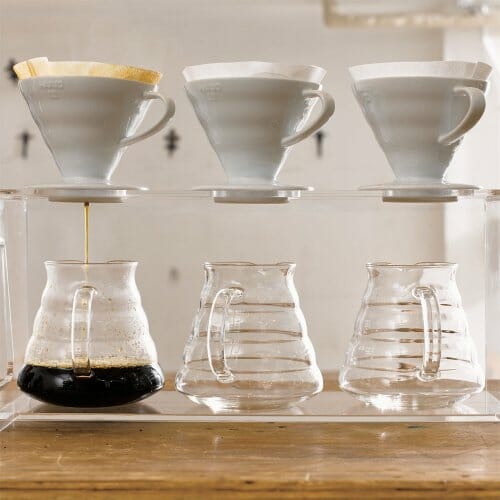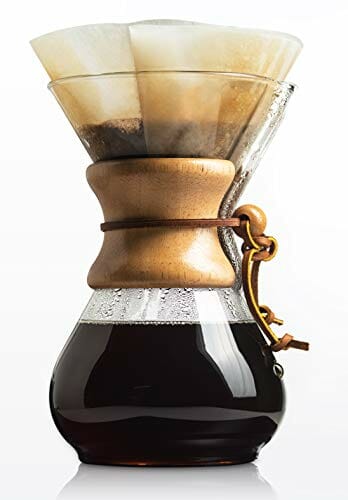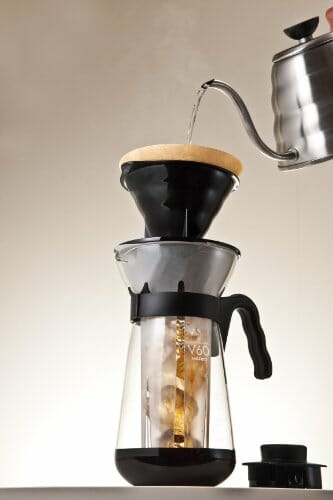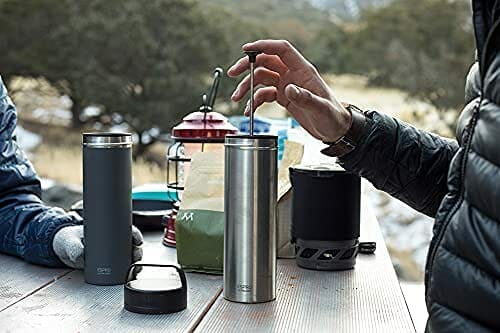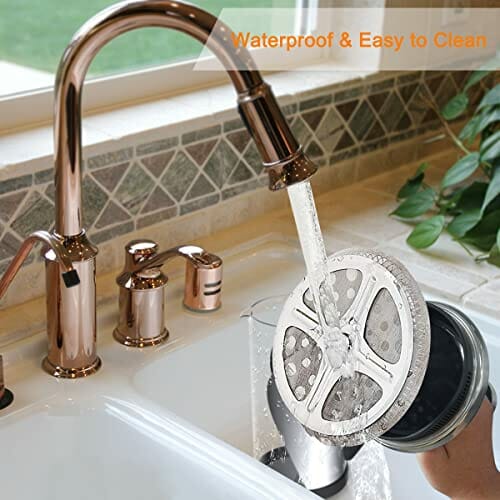Pour Over vs French Press coffee makers: The battle is as old almost as time itself.
Both are manual, affordable, and easy-to-navigate alternatives to their electricity-dependent counterparts.
In this article, I will show you a detailed comparison between French Press and Pour-Over coffee makers.
To pour or to plunge – Which brewing method would best suit your taste and lifestyle?
What Is A Pour-Over
Pour-Over is a manual coffee brewing method that involves pouring hot water over coffee grounds in a filter and letting it drain into a container below.
This is an infusion brewing method, a common technique among not only Pour-Overs, such as the Chemex and the Hario V60, but also other traditional drip coffee makers.
Basically, a constant flow of hot water slowly runs through the coffee grounds so that the coffee taste (coffee soluble) is passed to the hot water before it drains.
A good barista will also perform a small steeping routine before the real filtration.
This is done by adding just enough hot water to wet the coffee grounds and letting the ground bed steep and bloom for just 30 seconds at first.
You will be surprised by how noticeably brighter the brewed coffee becomes. Blooming lets your coffee breathe and releases carbon dioxide faster, reducing the sourness caused by this gas.
What’s so special about Pour-Over coffee is that the extraction follows the downward pace and flow of water, in other words, the natural pull of gravity.
But before the water hits the coffee, you have full control over the pour. The amount, the temperature, the angle, the infusion time, and so on.
Everything is manual so adjust your pouring technique as you go to get the best cup of coffee.
If you want to learn more about how to brew coffee using the Pour-Over methods, the two most common ones are the V60 and the Chemex, as aforementioned.
Check this article for the how-to-use and other intriguing details about these two devices.
Advantages Of Pour Over Methods
Extraction
Since it’s an infusion coffee brewing method, water flows through the ground bed to effectively extract the coffee soluble from the coffee grounds.
This pouring technique allows more time and a constant change of water for the favorable flavor compounds to be extracted.
Filter
Another factor that has a big impact on the final Pour-Over coffee is the filter.
To keep out the unwanted oils, annoying grounds, and bitter coffee notes, paper filters are placed in these Pour-Over devices.
This means you get a clean cup of filter coffee with brighter and more vibrant notes.
This is especially the case for Chemex coffee. Unlike most other coffee brewing devices that use your typical paper filter, Chemex calls for a special bonded filter.
For better filtration, it is much thicker than the “normal” drip coffee makers’.
And in case you’re wondering, yes, you also need to get a filter for the V60.
The latter’s is also cheaper and a lot easier to find. If you’re trying to save some bucks, folding the “normal” ones to fit the V60 works as well.
Control
As I’ve briefly mentioned above, you have full control over the pour which, in turn, will significantly affect the coffee-to-water contact time and how your coffee will turn out.

First, you have to take into consideration the ingredients:
- The quality and amount of coffee grounds
- The amount and temperature of the water
Next, you have to be mindful of the way you pour:
- The speed
- The angle
- The infusion time (how long)
A tip for a better Pour-Over is using a gooseneck kettle. This special kettle enables you to better control the flow rate and adjust your wrist whilst pouring.
Cleaning
Another advantage of using a Pour-Over coffee maker is the ease of clean-up. Since a filter is placed over the brewer that catches all of the excesses, all you need to do after making your favorite cup of coffee is discarding the filter and rinsing the device with water, some soap, and a soft sponge.
However, over time, some coffee oils and minerals may build up inside the Pour-Over coffee maker. After every six months, you should:
- Fill the device with a mixture of hot water and baking soda (commercial cleaning powder products and vinegar can work as well).
- Wait for at least 5 minutes. You can leave it for as long as a few hours.
- Discard the mix.
- Rinse it with water and use a non-abrasive brush with a wooden/plastic handle to gently scrub the surface.
- Rinse it once more with water and soap.
Simple, isn’t it?
Disadvantages Of Pour Over Methods
Brew Time
First, you have to wait a bit for the coffee to bloom and expand. Then more waiting is on the way as you let it naturally steep and drain while slowly pouring water over the coffee grounds bed.
Thus, this brewing technique takes a lot longer than electric drip machines and other manual brewing methods.
Moreover, since you are directly involved in every single step of brewing coffee, you can hardly leave the Pour-Over device to perform other morning routines in the meantime.
A rough estimate of the time it takes to brew a Pour-Over is at least 4 minutes. So it can be time-consuming for those who just want a quick morning recharge before heading out.
But the whole process along with the sweet coffee aroma may also appear quite calming and stimulating to some to shake themselves out of drowsiness. To each their own.
Ease Of Use
As aforementioned, how the cup of coffee turns out depends on your pouring technique. Theoretically speaking, it’s very simple to use. But, like most things in life, it’s easier said than done.
Therefore, there is a learning curve. So don’t worry if you don’t master the Pour-Over from day 1.
There are plenty of mornings for you to test your recipe and adjust your pouring method to achieve the desirable coffee. And it will be worth it!
Portability
Pour-Overs aren’t very compact and travel-friendly. The glass material also poses a higher risk of breaking if not handled carefully (especially you, Chemex).
If you are clumsy but still want a portable Pour-Over coffee maker, try looking into the V60 in more durable materials such as plastic like this one.
What Is A French Press
A French Press is another well-known manual coffee maker which is also known as a coffee press, a cafetiére, or a coffee plunger.
The working principle of a French Press is very simple:
- Add hot water and grounds to the beaker (borosilicate glass carafe).
- Let it steep.
- Press down the stainless steel plunger. The filter will keep the sludge at the bottom, leaving extracted coffee on top.
Different from the Pour-Over brewing process, the French Press method is a prime example of the immersion coffee brewing methods.
In a Pour-Over coffee maker, hot water is essentially infused with coffee extracts as it constantly flows through the ground bed.
But in a French Press, ground coffee is immersed in hot water as it steeps and extracts the coffee soluble into the same water over time.
Therefore, what matters here isn’t how you press, but the brewing time. That is aside from other deciding factors such as the quality of ground coffee, your brewing ratio, and the temperature of the water, of course.
And, since the extracted coffee sits in the same borosilicate glass carafe as the unwanted coffee ground, to avoid over-extraction, it’s advised to decant the French Press coffee brew to a different container if you don’t intend to serve it all at once.
This is also applied to coffee at home, so try to make a bit more effort for your future self.
However, there is one similar routine baristas should perform before implementing either brewing process: letting the coffee bloom.
Like you would with a Pour-Over, wet the ground bed with a little water and wait 30 seconds when using the French Press method.
If you’re curious to learn more about the French Press coffee brewing methods, click here for more detail on how to master this plunging brewing device.
Advantages Of The French Press
Brew Time
This round of French Press vs Pour-Over is a bit tricky. To brew French Press coffee, it also takes a minimum of 4 minutes.
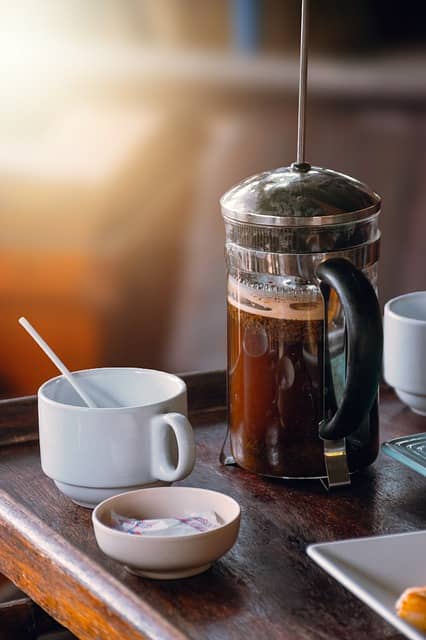
However, the difference lies in your involvement in the making of the brewed coffee. While you have to stick by the devices every step of the way using the Pour-Over method, you get to relax more with French Presses.
Set up a timer on your phone and go brush your teeth. A couple of minutes later, you’re back to a pleasant aroma in the air and coffee ready to be served.
Ease Of Use
Another aspect where the French Press prevails is user-friendliness, which is evident from how popular it is around the world. Just leave it all to the stainless steel plunger.
All you have to be mindful of is timing the brew to avoid over-extraction and under-extraction.
To improve your French Press coffee, pay more attention to:
- The quality of the coffee beans: Make sure you use the medium to dark roast. You can also get the single-origin type of coffee per your preference.
- The grind size of the grounds: It’s best to grind them yourselves right before brewing.
- The coffee-to-water ratio: A good starting point is 1:15.
- The water temperature: 195 – 205 degrees F (91 – 96 degrees C).
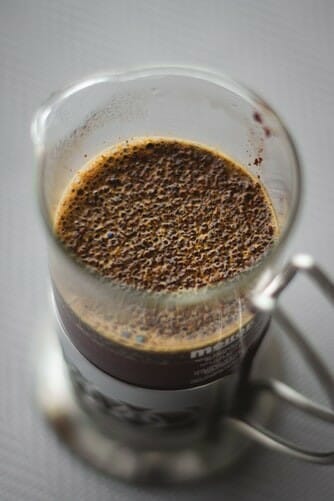
Versatility
In this French Press vs Pour-Over debate, French Press coffee once again scores for versatility. So what can you brew other than normal hot coffee?
- Cold Brew: By replacing hot water with cold water and extending the steeping time to at least 12 hours, you can brew this refreshing summer drink using a French Press. I’ve written a detailed article about that here.
- American coffee: Add more water.
- Latte, Cappuccino, and other milk-based drinks: Add milk, obviously.
- Iced Coffee: Add iced.
- Tea!
Portability
There are many portable French Press designs to satisfy your craving for French Press coffee on the go.
One of the most popular models is the Espro P0 Ultralight Stainless Steel French Press, which is light, made of durable material, and has a filter that stops extraction completely once plunged.
Check it out on here.
Disadvantages Of The French Press
Extraction
As mentioned above, French Presses brew coffee using the immersion brew method. Ground coffee is immersed in the same water the entire time, resulting in a more full-bodied and powerful coffee taste.
This is not necessarily a drawback for French Press and some coffee drinkers want it that way. But one more contributing factor to that strong taste is the filter.
The metal filter attached to the plunger rod cannot do as good of a job as the paper one, so some coffee oils, grounds, and bitter notes can still slip through.
So when you use the French Press, your cups of coffee won’t be as clean as those made using the Pour-Over method.
Cleaning
Since brewing using a French Press doesn’t call for a paper filter, you can’t just simply toss the sludge into the trash. That’s why some coffee lovers dread the aftermath when making coffee at home.
Though more efforts will be involved, the cleaning process is not complicated.
- Fill the beaker with water and give it some swirls.
- Pour the content into a mesh strainer and discard the sludge. DO NOT pour it directly into the sink if you don’t want to clog up your drain. Medium-coarse grind and oils have a bigger impact and build up more than you might think.
- If you don’t have a strainer, skip step 1, get a wooden spoon or spatula or use your hand to get as much sludge in the French Press beaker out. And again, DON’T dump it down the sink.
- Use water, soap, and a non-abrasive sponge to clean the carafe and the plunger. If the manufacturer says they are dish-washer friendly, why not make your life easier that way?
If you brew with the French Press often, once in a while, make sure to disassemble all of the parts along the plunger rod and give them and the beaker a rinse and scrub with a mix of water and baking soda (or vinegar).
This helps effectively remove the build-up of oils and minerals, preventing them from affecting the taste of your coffee cup.
What Is Better: French Press Or Pour-Over?
From the Pour-Over vs French Press battle, which coffee maker is better? Sadly, I can’t make the decision for you.
They both have their perks and downsides. But, I can offer some advice based on your brew preference and coffee-making habits:
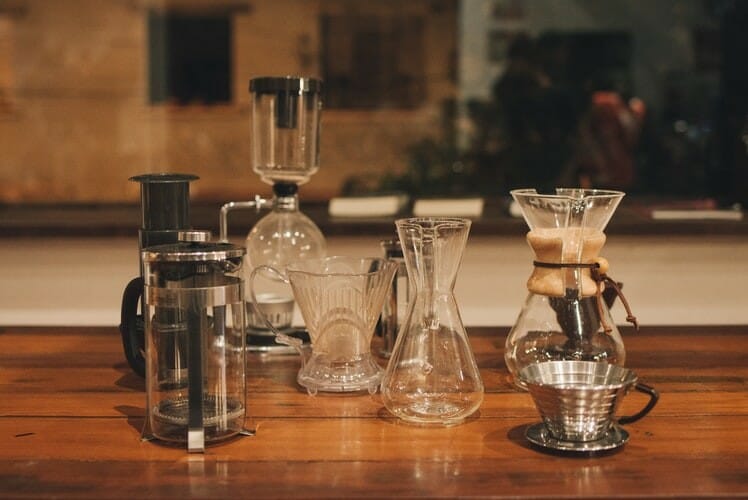
- Get a Pour-Over (Chemex or V60) if you prefer a clean and bright brew suitable for specialty coffee, more hands-on, and a simpler clean-up.
- Get a French Press if you prefer a strong and full-bodied taste, an easier-to-pull-off process, and more menu versatility.


